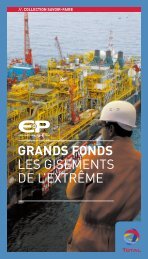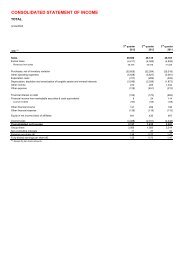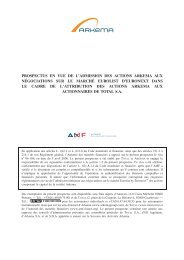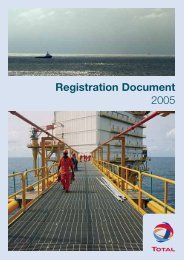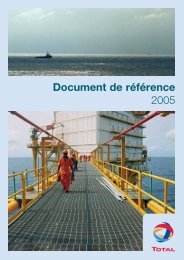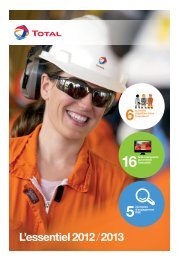Registration document 2007 - Total.com
Registration document 2007 - Total.com
Registration document 2007 - Total.com
You also want an ePaper? Increase the reach of your titles
YUMPU automatically turns print PDFs into web optimized ePapers that Google loves.
9<br />
• property, plant and equipment, and intangible assets are<br />
measured using historical cost model instead of revaluation<br />
model;<br />
• interest expense incurred during the construction and<br />
acquisition period of tangible and intangible assets are<br />
capitalized, as provided for under IAS 23 “Borrowing Costs”;<br />
• actuarial gains and losses on pension and other postemployment<br />
benefit obligations are recognized according to<br />
the corridor method as from January 1, 2004 (see note 1R to<br />
the consolidated financial statements);<br />
• jointly-controlled entities are consolidated using the<br />
proportionate method, as provided for in IAS 31 “Interests in<br />
Joint Ventures”.<br />
X. New accounting principles not yet in effect<br />
The standards or interpretations published respectively by the<br />
International Accounting Standards Board (IASB) and the<br />
International Financial Reporting Interpretations Committee<br />
(IFRIC) which were not yet in effect at December 31, 2006, were<br />
as follows:<br />
(i) IFRS 7 “Financial Instruments: disclosures”<br />
In August 2005, the IASB issued IFRS 7 “Financial Instruments:<br />
Disclosures”. The new standard replaces IAS 30 “Disclosures in<br />
financial statements of Banks and Similar Financial Institutions”<br />
and provides amendments to IAS 32 “Financial Instruments:<br />
Disclosure and Presentation”. IFRS 7 requires disclosure of<br />
qualitative and quantitative information about exposure to risks<br />
resulting from financial instruments. Entities shall apply IFRS 7 to<br />
annual periods beginning on or after January 1, <strong>2007</strong>. The<br />
application of IFRS 7 should not have any material impact for the<br />
Group given the disclosures already presented in the<br />
consolidated statements for the year ended December 31, 2006.<br />
(ii) IFRS 8 “Operating segments”<br />
In November 2006, the IASB issued IFRS 8 “Operating<br />
segments”. The new standard replaces IAS 14 “Segment<br />
reporting”. It requires entities to adopt an approach based on<br />
internal information used by the management of the entity to<br />
determine reportable segments, whereas IAS14 is based on<br />
segment risks and profitability. Entities shall apply IFRS 8 to<br />
annual periods beginning on or after January 1, 2009. The<br />
application of IFRS 8 should not have any material impact for the<br />
Group given the disclosures already presented in the<br />
consolidated financial statements of the Group.<br />
(iii) IFRIC 9 “Reassessment of Embedded Derivatives”<br />
In March 2006, the IFRIC published interpretation IFRIC 9<br />
“Reassessment of Embedded Derivatives”. The interpretation<br />
addresses embedded derivatives within the scope of IAS 39<br />
relating to Financial Instruments and their reassessment. IFRIC 9<br />
concludes that an entity must assess whether an embedded<br />
derivative is required to be separated from the host contract and<br />
accounted for as a derivative when the entity first be<strong>com</strong>es a<br />
180<br />
Appendix 1 – Consolidated financial statements<br />
Notes to the consolidated financial statement<br />
TOTAL – <strong>Registration</strong> Document 2006<br />
party to the contract. Subsequent reassessment is prohibited<br />
unless there is a significant change in the terms of the contract.<br />
IFRIC 9 is effective for annual periods beginning on or after<br />
June 1, 2006. The application of IFRIC 9 should not have any<br />
material effect on the Group’s balance sheet, in<strong>com</strong>e statement<br />
and consolidated shareholder’s equity.<br />
(iv) IFRIC 10 “Interim Financial Reporting and Impairment”<br />
In July 2006, the IFRIC published interpretation IFRIC 10 “Interim<br />
Financial Reporting and Impairment”. In accordance with IFRIC<br />
10, an entity shall not reverse an impairment loss recognized in a<br />
previous interim period in respect of goodwill or an investment in<br />
either an equity instrument or a financial asset carried at cost, in<br />
subsequent interim or annual period. IFRIC 10 is effective for<br />
annual periods beginning on or after November 1, 2006. The<br />
application of IFRIC 10 should not have any material effect on the<br />
Group’s balance sheet, in<strong>com</strong>e statement and consolidated<br />
shareholder’s equity.<br />
2) Main indicators – information by business segment<br />
Performance indicators excluding the adjustment items, such as<br />
adjusted operating in<strong>com</strong>e, adjusted net operating in<strong>com</strong>e,<br />
adjusted net in<strong>com</strong>e are meant to facilitate the analysis of the<br />
financial performance and the <strong>com</strong>parison of in<strong>com</strong>e between<br />
periods.<br />
Adjustment items:<br />
(i) Special items<br />
Due to their unusual nature or particular significance, certain<br />
transactions qualified as “special items” are excluded from the<br />
business segment figures. In general, special items relate to<br />
transactions that are significant, infrequent or unusual. However,<br />
in certain instances, transactions such as restructuring costs or<br />
assets disposals, which are not considered to be representative<br />
of the normal course of business, may be qualified as special<br />
items although they may have occurred within prior years or are<br />
likely to occur again within the <strong>com</strong>ing years.<br />
(ii) The inventory valuation effect<br />
The adjusted results of the Downstream and Chemical segments<br />
are also presented according to the replacement cost method.<br />
This method is used to assess the segments’ performance and<br />
ensure the <strong>com</strong>parability of the segments’ results with those of<br />
its <strong>com</strong>petitors, mainly North-American.<br />
In the replacement cost method, which approximates the LIFO<br />
(Last-In, First-Out) method, the variation of inventory values in the<br />
in<strong>com</strong>e statement is determined by the average prices of the<br />
period rather than the historical value. The inventory valuation<br />
effect is the difference between the results according to the FIFO<br />
(First-In, First-Out), and the replacement cost.




